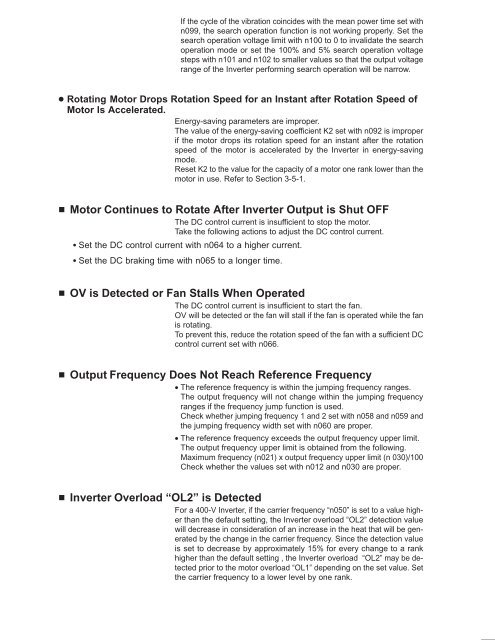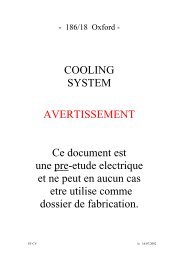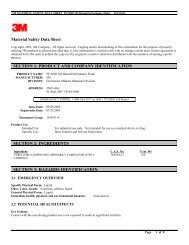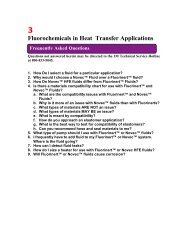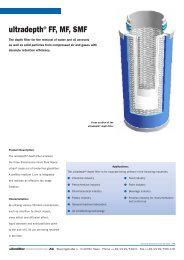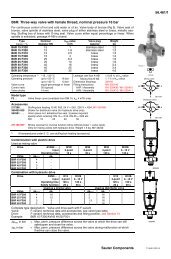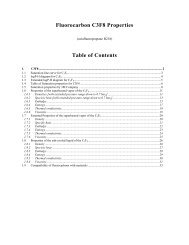OMRON Sysdrive 3G3HV - Detector Cooling Section
OMRON Sysdrive 3G3HV - Detector Cooling Section
OMRON Sysdrive 3G3HV - Detector Cooling Section
Create successful ePaper yourself
Turn your PDF publications into a flip-book with our unique Google optimized e-Paper software.
If the cycle of the vibration coincides with the mean power time set with<br />
n099, the search operation function is not working properly. Set the<br />
search operation voltage limit with n100 to 0 to invalidate the search<br />
operation mode or set the 100% and 5% search operation voltage<br />
steps with n101 and n102 to smaller values so that the output voltage<br />
range of the Inverter performing search operation will be narrow.<br />
Rotating Motor Drops Rotation Speed for an Instant after Rotation Speed of<br />
Motor Is Accelerated.<br />
Energy-saving parameters are improper.<br />
The value of the energy-saving coefficient K2 set with n092 is improper<br />
if the motor drops its rotation speed for an instant after the rotation<br />
speed of the motor is accelerated by the Inverter in energy-saving<br />
mode.<br />
Reset K2 to the value for the capacity of a motor one rank lower than the<br />
motor in use. Refer to <strong>Section</strong> 3-5-1.<br />
Motor Continues to Rotate After Inverter Output is Shut OFF<br />
The DC control current is insufficient to stop the motor.<br />
Take the following actions to adjust the DC control current.<br />
Set the DC control current with n064 to a higher current.<br />
Set the DC braking time with n065 to a longer time.<br />
OV is Detected or Fan Stalls When Operated<br />
The DC control current is insufficient to start the fan.<br />
OV will be detected or the fan will stall if the fan is operated while the fan<br />
is rotating.<br />
To prevent this, reduce the rotation speed of the fan with a sufficient DC<br />
control current set with n066.<br />
Output Frequency Does Not Reach Reference Frequency<br />
•The reference frequency is within the jumping frequency ranges.<br />
The output frequency will not change within the jumping frequency<br />
ranges if the frequency jump function is used.<br />
Check whether jumping frequency 1 and 2 set with n058 and n059 and<br />
the jumping frequency width set with n060 are proper.<br />
•The reference frequency exceeds the output frequency upper limit.<br />
The output frequency upper limit is obtained from the following.<br />
Maximum frequency (n021) x output frequency upper limit (n 030)/100<br />
Check whether the values set with n012 and n030 are proper.<br />
Inverter Overload “OL2” is Detected<br />
For a 400-V Inverter, if the carrier frequency “n050” is set to a value higher<br />
than the default setting, the Inverter overload “OL2” detection value<br />
will decrease in consideration of an increase in the heat that will be generated<br />
by the change in the carrier frequency. Since the detection value<br />
is set to decrease by approximately 15% for every change to a rank<br />
higher than the default setting , the Inverter overload “OL2” may be detected<br />
prior to the motor overload “OL1” depending on the set value. Set<br />
the carrier frequency to a lower level by one rank.


